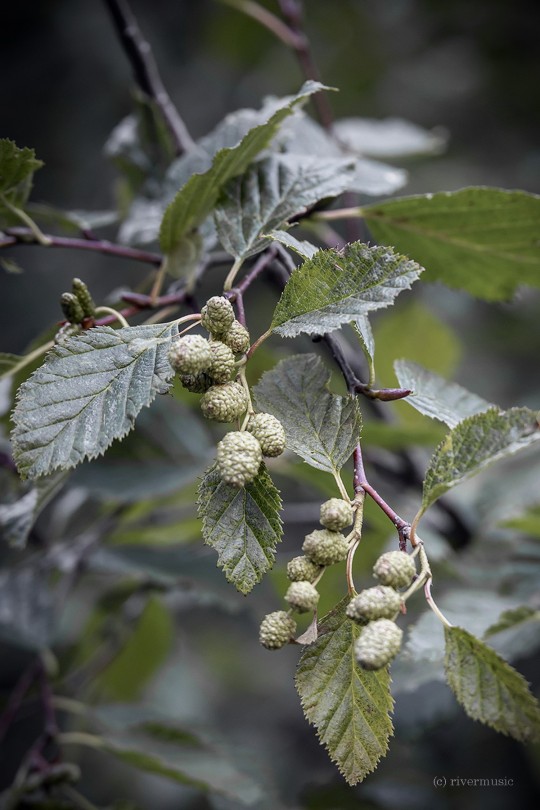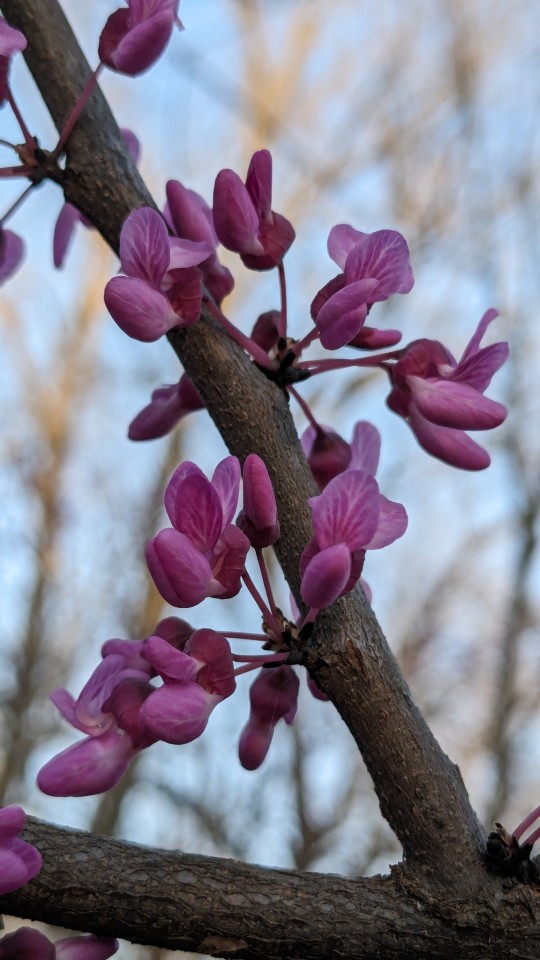#Native Trees
Explore tagged Tumblr posts
Text
Met with a local forester last week because there is a free tree program in my town and we signed up. The electric company just came by to mark where the trees are going!
We're getting a street tree and a yard tree. I requested a Black Walnut for the street. No one ever asks for those, I guess, and the forester was really excited that we wanted one. If that's not available, we'll be getting a White Oak.
The yard tree is what I'm most excited about. I asked if they had any native fruiting trees and she says, "Well we don't have a lot of options for that, but if you're looking for something that fruits..."
She flips to a page in her tree species book and shows me a Serviceberry! I was ecstatic.
If you own your home definitely look into free tree programs or greening initiatives near you. My city is pretty urban, so the goal of this project is to add more trees in order to support wildlife and reduce the "Urban Heat Island effect".
I will definitely be showing off photos of my new Serviceberry once planted.
1K notes
·
View notes
Text



willow thicket...
276 notes
·
View notes
Text

Benthamidia florida / Flowering Dogwood at the Sarah P. Duke Gardens at Duke University in Durham, NC
#Benthamidia florida#Benthamidia#Cornus florida#Cornus#Cornaceae#Flowering Dogwood#Large Bracted dogwood#Dogwood#Native plants#Native flowers#Native trees#Plants#Flowers#Trees#Nature photography#Photography#photographers on tumblr#Sarah P. Duke Gardens#Duke Gardens#Duke University#Durham#Durham NC#north carolina#🌺🌻
34 notes
·
View notes
Text


⋆₊⟡ eastern redbud in bloom ✿⊹˚₊‧
#forest doll#eastern redbud#bloom#pink blossoms#pink flowers#pink blooms#pink#pink aesthetic#spring flowers#flowers#native plants#native trees#ohio#Ohio native#forest#enchanted woodland#magic#nature#fairy#woodland#art#my photo#fairycore#cottagecore#whimsigoth#nature photography#nature art#botanical art#botany#glitch art
34 notes
·
View notes
Text

Green Alder, (Alnus alnobetula) with new cones, heads into Autumn
(c) riverwindphotography, September 2023
287 notes
·
View notes
Text
youtube
Rahway, New Jersey, faces major environmental challenges—poor air quality, urban heat, and polluted waterways—all made worse by limited tree cover. But change is happening.
✅ Subscribe to One Tree Planted: https://bit.ly/2IsCtqc
🌳 Plant Trees: https://onetreeplanted...
In this mini-documentary, we explore how Groundwork Elizabeth, backed by local leadership, is transforming the city with over 400 newly planted trees and an innovative Miyawaki microforest in Grover Cleveland Park. 🌱 This densely planted, fast-growing forest will restore biodiversity, improve air and water quality, and provide hands-on environmental education for local students.
🌲 About One Tree Planted:
One Tree Planted is a 501(c)(3) non-profit organization and we plant trees! We are a tree planting charity with a goal: to make it as simple as possible for anyone to plant trees.
#One Tree Planted#solarpunk#miyawaki forest#mini forest#micro forest#tiny forest#Rahway#new jersey#USA#Grover Cleveland Park#native plants#native trees#native species#Merck#urban forest#Youtube
15 notes
·
View notes
Text




𝑻𝒘𝒐 𝒑𝒂𝒕𝒉𝒔 𝒂𝒉𝒆𝒂𝒅…🌿
#trees and forests#treecore#palm trees#stairs#stairs in nature#staircase#walking in nature#naturecore#nature#cottagecore#forestcore#natural#forest#greencore#lush#shades of green#greenery#water stream#waterfall#native trees#green
32 notes
·
View notes
Text

Eastern Redbud Tree
Cercis canadensis
This small tree in the legume family showcases lovely pink blooms in spring and is native to much of eastern North America. They grow in a variety of habitats, but prefer well-drained slopes in woods without many other plants to compete with. Its flowers are pollinated by carpenter bees and other bees with long tongues, and the leaves provide food for several caterpillar and moth species. The flowers on this tree are also edible and contain beneficial anthocyanins, a group of antioxidants.
March 19th, 2024
St. Charles County, Missouri, USA
Olivia R. Myers
@oliviarosaline
#botany#legumes#trees#plants#fabaceae#cercis#flowering trees#redbud#eastern redbud#native plants#native trees#woods#Missouri#Cercideae#naturecore#nature#forest#cottagecore#fairycore#foraging#forage#wildflowers#wild foods#ecology#flowers#nature photography#flower photography#plant photography#spring#Cercis canadensis
56 notes
·
View notes
Text
Winter Trees and Shrubs: Box Elder
Box elder is a maple that doesn’t often get credit for being a maple. Moreso, it is a tree that is not thought highly of, and it may not even be welcome in certain discussions around maples. You could even say that box elder is a “rogue maple,” as Arthur Plotnick deems it in The Urban Tree Book. It should come as no surprise, but if people are going to talk about a plant this way, it’s only going…

View On WordPress
#Acer negundo#Arthur Plotnick#ash trees#bark#Boise Idaho#Botany#box elder#horticulture#John Eastman#native trees#tree identification#urban ecology#weedy trees#Winter Botany#winter buds#Winter Trees and Shrubs#winter twigs
17 notes
·
View notes
Text
Took all afternoon but I planted all but 3 bare-root babies - about 40 new native shrubs, bushes, and trees. I didn't water them in because it's supposed to rain all night, but I'm beyond happy with the haul 🌳😊🌲


These were free and still very young so none are available for sale - I'll give away and trade some to friends, neighbors, and local orgs rewilding habitats. I'll also make sure to save one of each (except the largest trees off to permanent destinations) to propagate scions from a couple times a year and be sure my local community and wherever I end up will be supplied with native landscaping options for years to come.
This is all possible because of free and nonprofit orgs working to make native landscaping accessible to everyone. Today's giveaway was hosted by Friends of Trees, who have locations and events throughout the states of Oregon and (I believe) Washington. Agrarian Sharing Network is another excellent resource that will be sharing free seed and fruit tree scions throughout the state in March!
Find out more at their website, and if you're out of reach of this program keep an eye out for similar groups local to your area!! Stay tuned for info on bare-root planting, and how to plant large shrubs and trees
#pacific northwest#friends of trees#hopepunk#solarpunk#gardening#native landscaping#community action#pnw gardening#zone 8 gardening#oregon#pnw#oregon gardening#garden#zone 8#green witch#native trees#pnw native plants
7 notes
·
View notes
Text
Happy International Day of Forests!
May every forest flourish in its unique diversity, providing diverse ecosystems and homes for all wildlife , oxygen for everyone, and sustain all life on earth - and may people, all humans wake up to their inherent worth and value, and protect them - and all native trees everywhere - from being cleared in the arrogance of anthropocentrism.
#Forests#International Day of Forests#Earth#21st March 2024#International Day of Forests 2024#International Day of Forests 21st March 2024#Nature#Trees#Ecosystems#Wildlife#Keep your native trees#Plants#Keep your native plants#Native plants#Native trees
38 notes
·
View notes
Text



black hawthorn...
212 notes
·
View notes
Text

Rhododendron austrinum / Florida Flame Azalea at the Sarah P. Duke Gardens at Duke University in Durham, NC
#Rhododendron austrinum#Rhododendron#Ericaceae#Florida flame Azalea#Flame Azalea#Honeysuckle Azalea#Orange Azalea#Azalea#Azaleas#Native plants#Native flowers#native trees#Plants#Flowers#Shrubs#Nature photography#Photography#photographers on tumblr#Sarah P. Duke Gardens#Duke Gardens#Duke University#Durham#Durham NC#north carolina#🌺🌻
22 notes
·
View notes
Text


First: Mano de Oso (Oreopanax incisus)
Second: Unknown / A very lovely fern
2 notes
·
View notes
Text

48 notes
·
View notes
Text
youtube
Rising temperatures sparked by global warming have led to an even hotter urban climate, created by the so-called heat island effect. Hong Kong-based social enterprise Nature Makers Lab is seeking to help ease the effects of warm air trapped in urban spaces by planting mini forests around the city that also promote biodiversity. Based on a system invented by Japanese botanist Akira Miyawaki, Hong Kong’s first dense mini-forest project was carried out with the help of a group of primary school pupils.
(Photo: SCMP / Jonathan Wong)
Related story:
How Japan’s tiny forests are helping to cool India’s heat islands https://sc.mp/vb7t
Posted on YouTube on September 11th, 2021.
#South China Morning Post#solarpunk#miyawaki forest#tiny forest#mini forest#micro forest#hong kong#urban forest#forest#planting trees#native trees#Nature Makers Lab#Youtube
3 notes
·
View notes